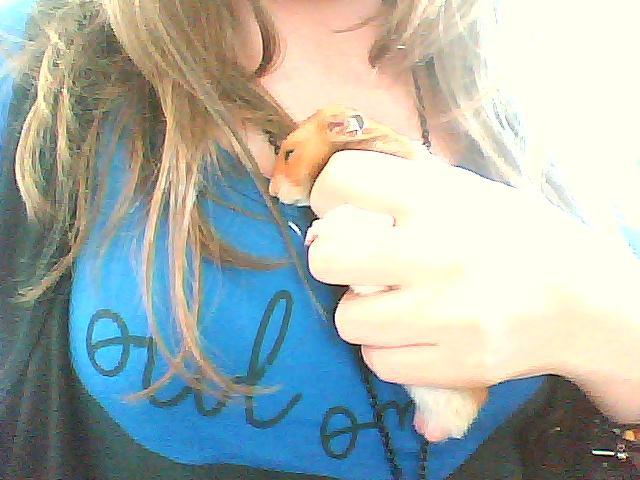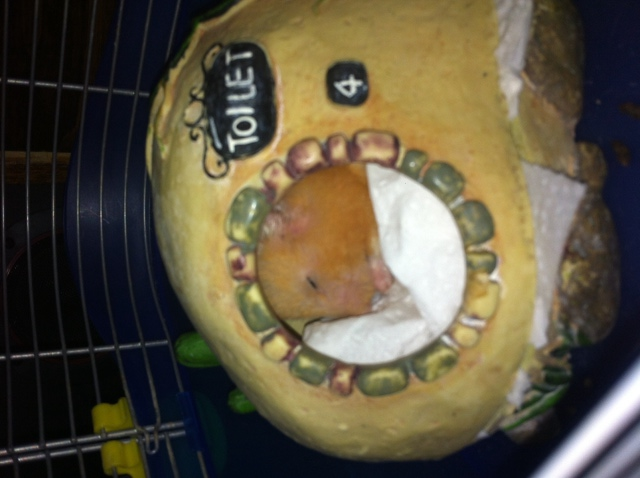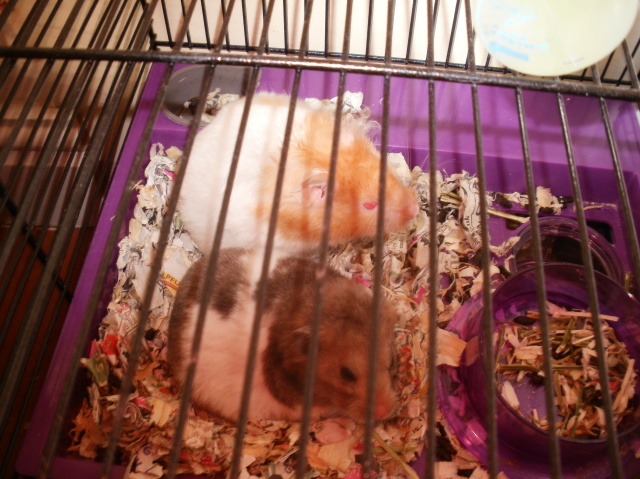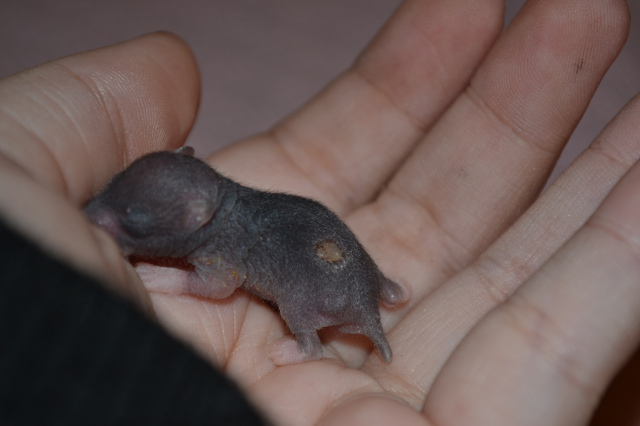QuestionHi,
as you can see, my name's Erika, I'm 16 & this is not my 1st hamster but my 1st pregnant 1 :) I did not know she was pregnant when I bought her but I'm very excited all the same. I just need to know the basics as to what to feed her, when to clean the bedding, how much can she be touched, and what to do to avoid cannibalism. Any info on some or hopefully all these things would be very appreciated. Also, she is a Teddy hamster and I'm guessing will be giving birth soon since I've had her for about 2 weeks now & she's very round.
AnswerHi Erika
I always get excited when the local rescue center phones me to tell me they've got a pregnant Syrian for me to have for a few weeks - I just love having babies! But, however, occasionally things do go wrong and you need to be careful.
First of all - gestation period is around 16-18 days - so as you say, yours will be producing the litter any day now. The litter can be anything up to around 12 babies - although often it's around 6. If you want to clean her out before the litter arrives - that is fine - but just change the wood chippings - let her have her nest back as she will be busy getting this ready. It is a good idea to clean her now as when she's had the babies, I don't clean them for at least 2 weeks - just remove the soiled woodchippings in the corner. She will be drinking a lot more water now, so just make sure she's got clean water every day. Don't overfeed her - just give her the usual amount of food. What type of cage have you got her in? Can you remove any plastic houses etc inside the cage? It would be better for her to have her litter in the open or under a platform. You don't want her having her litter inside a house, or coconut shell etc. I'm assuming she's got a solid wheel? If not, you might want to get one or two of these - you don't want wheels with bars or openings. When the babies are a few weeks old they will all want to run in the wheel at the same time and they can sustain injuries - so you will need the solid plastic wheels - as many as you can fit in your cage to avoid squabbling. Also, what bedding are you using? Don't use the fluffy bedding as they can get this caught around their legs and cause serious injuries - you need the paper bedding.
Make sure the cage is in a quiet area - i.e. away from other animals. Is she tame? If you can, keep talking to her and let her out for a play so she gets used to you while you're waiting for the litter to arrive. when she goes into labor, just leave her to get on with it. I find this usually happens in the evening or during the night - I discover the litter in the morning.
You'll know if she's given birth - apart from the fact that there might be a small amount of blood on the bedding, when she looks out of the bedding she will look tired and if you listen carefully you'll hear the babies feeding. It is very tempting to look in the nest, but I always try to avoid this in these early days. Drop some food near the mum so she can reach out of her nest and feed. She also needs a small amount of fresh vegetables each evening. Also, buy a packet of human baby food powder - the creamy porridge oats is the most popular. Mix up a small amount and put it in a dish or on a jamjar lid close to the nest each day. This will help her get extra nutrients. When the babies leave the nest (in about 10-14 days) if the dish is low enough they can eat this too.
When she leaves the nest to have a run in her wheel, or get a drink, she should tuck the nest in to keep her babies warm. Any baby that is out of the nest for the first week can die in a matter of minutes as their body temperature drops dramatically. If when you are putting food in the cage for her you accidentally touch the nest or one of her babies - then gently place your hand on all the babies and all round the cage so that your scent is everywhere and not just on one baby.
If she feels threatened, or if any of her babies are ill - she might kill them. Fortunately, I've only had one disaster in all the litters I've raised and this was because I tried to get her and her litter in a larger cage (something I've done many times before so it was nothing unusual) when the babies were about a week old and the mum went crazy and two babies ended up dead - she didn't kill them but they ended up out of the nest and died from hypothermia. I'll never make that mistake again. I also never clean them out for at least 2 - 3 weeks (it all depends on how smelly the cage is and how the mum is behaving)- and when I do I don't use disinfectant on the cage - just a quick wash round, and I give some of their bedding back so that she recognizes the smell.
After a few days you might be able to have a quick look in the nest - if she will allow it. Some mums are very aggressive and protective when there are young around, so you might have to wait. Don't handle the babies at this stage. The only time you should handle any is if you find one out of the nest and you need to gently pop it back in.
After one week you should be dropping tiny pieces of food into the nest for the babies - raw porridge oats, pieces of bread, seeds etc.
When they get to be around 10 days old they start leaving the nest to go and have wee! It is very funny to watch. At this stage you should start handling them. They will still have their eyes closed at this age. Make a fuss of the mum too so she doesn't feel left out. Try and handle all the babies a couple of times a day. They will go through the 'pinging' stage when they can fly out of your hands, but the more you handle them the tamer they will become and the better pets they will make. When the babies are 3 weeks old, you might want to let the mum out for a run in an exercise ball for a short time - 20 minutes in the evening. Make sure she can't escape from her ball as you don't want to lose her now. When they start leaving the nest make sure there is a water supply for them - you can either do this by creating a stairway up to the water bottle, or I usually put two bottles in the cage - one for mum and the one I use for the babies I tape inside the cage at a lower level. It gets a bit messy as the water can drain so you have to be careful, but this is the only way I've found to do this. Once the babies are over 3 weeks old, if they are large enough they'll be able to drink from mum's bottle.
At 4 weeks to the day, you must sex and separate out the boys. They then stay in their cage for the next couple of weeks, the girls can stay with the mum providing they're not pestering her too much and squabbling. If it is a big litter and you think the mum is getting run down with all the work, then at 4 weeks you can take her away from her babies. I usually home the hamsters at 6 weeks - at this age they often start fighting so they will need their own cages.
Good luck with this - I hope this information helps you and isn't too confusing. Let me know when she gives birth and if there is anything else I can help you with.
Regards
Hi Erika
this is fantastic news that your hamster has had her litter - it's very exciting.
Moving any tubes out of the cage now would be good - and if you can block off any areas so that she doesn't get separated from her young. If you do this gently and talk to her all the time so she doesn't have any nasty surprises. One thing that sometimes happens is that the mum wants to leave the nest with her babies still attached to her feeding, and occasionally she leaves a trail of babies! Normally the mum will pick them up and put them back in the nest - but if they don't this is when you need to intervene and put them back for her - you don't want her going off climbing or whatever right now.
If you feel happier with her in a bigger/better cage - the only way I would suggest doing this is to clean the cage throughly. Get some of her soiled bedding and put that in it - you can rub it around a bit to get her scent there. Then, very carefully, lift the entire nest in one go - babies and mum and relocate it. Be careful because sometimes their nests don't have a bottom to them and you don't want to leave any behind. Before you do this check to see how she is with the babies - is she feeding them, looking after them OK like a good mum or is she scatty and leaving the nest open? If she is a good mum then you could do this, although I'd wait until tomorrow as the babies are incredibly fragile straight after birth. The danger is that the new scent will panic the mum and she will run around worrying that another hamster is there and she is threatened. If she isn't taking much care of her litter and doesn't want to be in the nest with them, then leave well alone. Just block off/remove any tubes until the babies start leaving the nest. It is a lot harder to move the nest then as the babies will all be crawling and the mum can sometimes get into a bit of a panic at that time as they keep running after the babies and dragging them back to the nest, often by a leg!
This is always a difficult decision to make - I have moved a litter and their mum all in one go out of a coconut shell - but still inside their same cage the day after she gave birth and everything was fine. But, as I told you earlier, I've had a bad experience too - it really depends on the temperament of the mum. Most will take it in their stride, but sadly some get scared so you need to seriously consider your options.
I think your first priority is to remove/change the wheel, and block off any tubes so that no one can get separated - and they are all together in the same area. Then review the situation in the next day or two. The bedding you have sounds fine. Make a lot of fuss of the mum - but I usually avoid handling them too much in the first few days - you want her to realise that her job is to raise her young - not to go out and play!
Hope this helps a bit. Feel free to ask any other questions.

 Vincent my hamster
Question
this is vincent
my hamster has a small lump on
Vincent my hamster
Question
this is vincent
my hamster has a small lump on
 My Hamster hasnt peed in 2-3 days!!! HELP...
Question
My Lil Bit
I have a female Syrian hamst
My Hamster hasnt peed in 2-3 days!!! HELP...
Question
My Lil Bit
I have a female Syrian hamst
 hamster cadge
Question
my hamsters
what should the normal hamster cad
hamster cadge
Question
my hamsters
what should the normal hamster cad
 Why does my baby hamster have a huge hole in its skin?
Question
Baby hamster
My hamster babies are 6 da
Why does my baby hamster have a huge hole in its skin?
Question
Baby hamster
My hamster babies are 6 da
 Winter White Hamster Bald spot
Question
Bald spot Flash Bald Spot No Flash
Winter White Hamster Bald spot
Question
Bald spot Flash Bald Spot No Flash